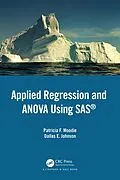Applied Regression and ANOVA Using SAS® has been written specifically for non-statisticians and applied statisticians who are primarily interested in what their data are revealing. Interpretation of results are key throughout this intermediate-level applied statistics book. The authors introduce each method by discussing its characteristic features, reasons for its use, and its underlying assumptions. They then guide readers in applying each method by suggesting a step-by-step approach while providing annotated SAS programs to implement these steps.
Those unfamiliar with SAS software will find this book helpful as SAS programming basics are covered in the first chapter. Subsequent chapters give programming details on a need-to-know basis. Experienced as well as entry-level SAS users will find the book useful in applying linear regression and ANOVA methods, as explanations of SAS statements and options chosen for specific methods are provided.
Features:
.Statistical concepts presented in words without matrix algebra and calculus
.Numerous SAS programs, including examples which require minimum programming effort to produce high resolution publication-ready graphics
.Practical advice on interpreting results in light of relatively recent views on threshold p-values, multiple testing, simultaneous confidence intervals, confounding adjustment, bootstrapping, and predictor variable selection
.Suggestions of alternative approaches when a method's ideal inference conditions are unreasonable for one's data
This book is invaluable for non-statisticians and applied statisticians who analyze and interpret real-world data. It could be used in a graduate level course for non-statistical disciplines as well as in an applied undergraduate course in statistics or biostatistics.
Autorentext
Patricia F. Moodie is a Research Scholar in the Department of Mathematics and Statistics at the University of Winnipeg, Manitoba, Canada. Prior to that she was Head of Biostatistics in the Computer Department for Health Sciences in the College of Medicine, University of Manitoba, an adjunct lecturer in Biometry in the Department of Social and Preventive Medicine at the University of Manitoba, and a biostatistician in the Epidemiology and Biostatistics Department at the Manitoba Cancer Treatment and Research Foundation. Her statistical consulting and collaboration for over three decades as well as her substantive background in the biomedical sciences have made her appreciate the challenges in analyzing and interpreting real-life data. She received a BSc(Hons) in Biology at Memorial University of Newfoundland, an MSc in Zoology at the University of Alberta, and an MS in Biostatistics at the University of Illinois at Chicago. She has been an enthusiastic SAS user since 1980.
Dallas E. Johnson is Professor Emeritus of Statistics at Kansas State University.
Inhalt
1. Review of Some Basic Statistical Ideas
2. Introduction to Simple Linear Regression
3. Model Checking in Simple Linear Regression
4. Interpreting a Simple Linear Regression Analysis
5. Introduction to Multiple Linear Regression
6. Before Interpreting A Multiple Linear Regression
7. Additive Multiple Linear Regression
8. Two-Way Interaction Between Continuous Predictors
9. Qualitative and Continuous Predictor Interaction
10. Predictor Subset Selection
11. Evaluating Equality of Group Means
12. Simultaneous Inference
13. Adjusting Group Means for Nuisance Variables
14. Alternative Approaches
